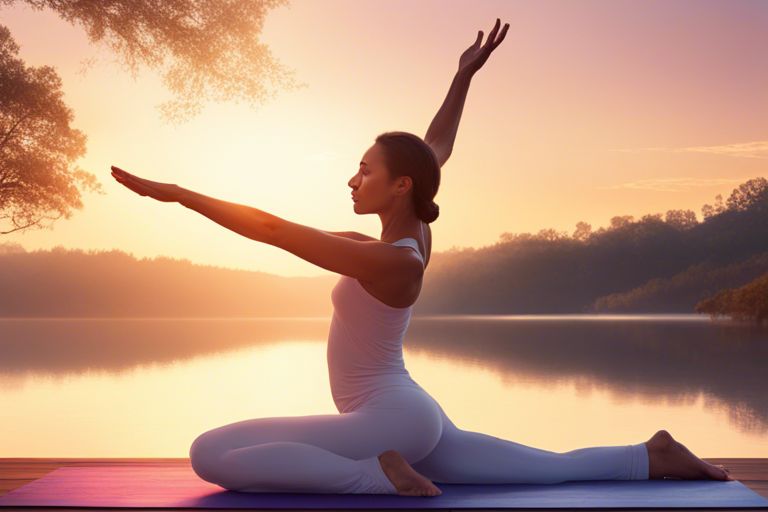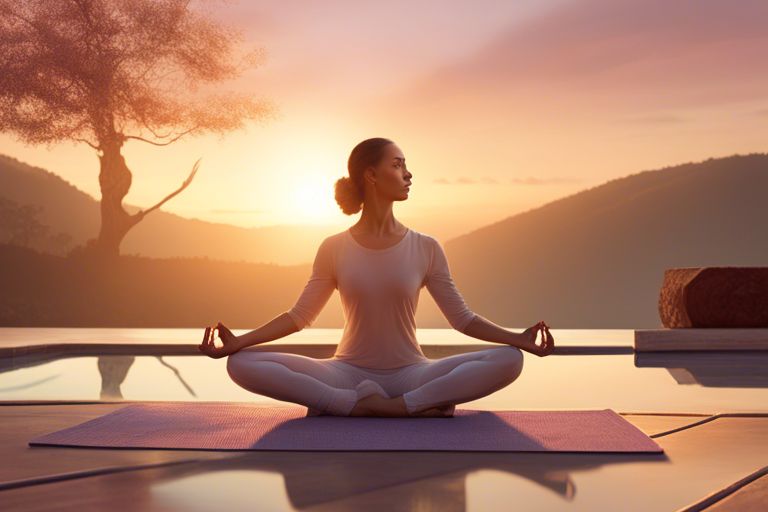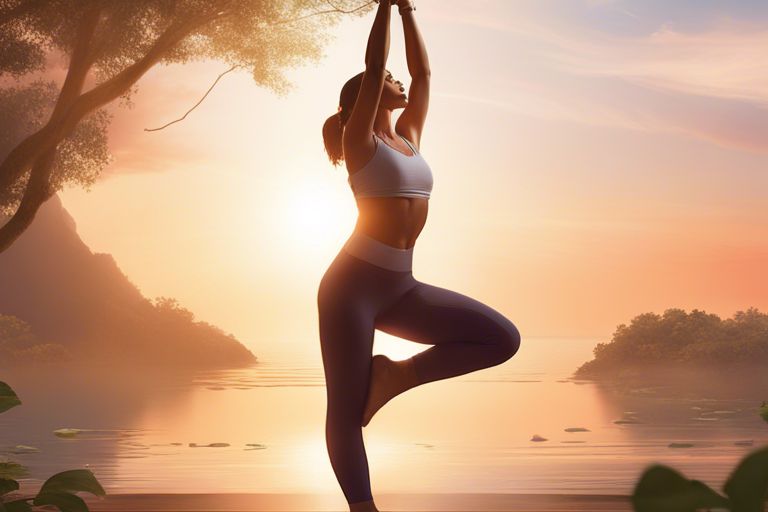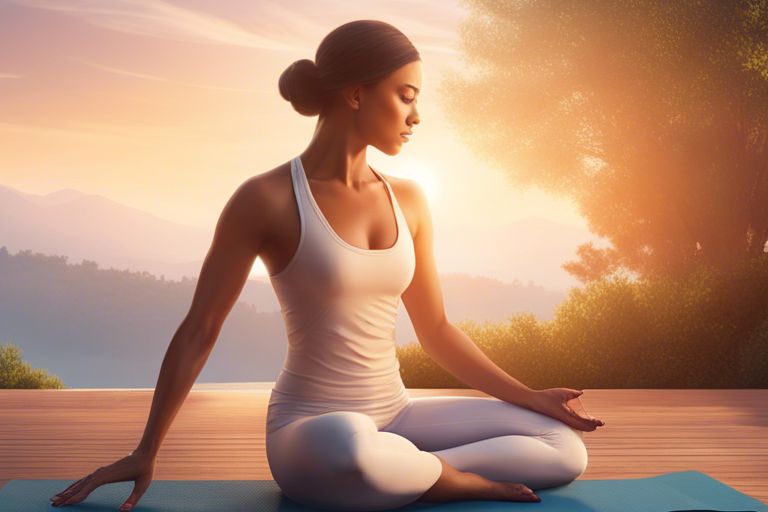Overwhelmed with your regular yoga routine and itching to take it up a notch? Dive into this Advanced Yoga Workout Plan to elevate your practice and challenge your body in new ways. Discover effective poses, breathing techniques, and flow sequences designed to push your limits and enhance your yoga journey. For a more comprehensive guide on yoga workout routines, check out our detailed article.

Key Takeaways:
- Variety: Incorporating a variety of advanced yoga poses and sequences can help level up your practice and challenge your body in new ways.
- Consistency: Regular practice is imperative to progress in advanced yoga. Make a commitment to practice consistently to see improvements in strength, flexibility, and mental clarity.
- Alignment: Paying attention to proper alignment in advanced yoga poses is crucial to prevent injury and deepen the benefits of the practice. Focus on alignment cues from instructors and listen to your body’s feedback.
1. Start with a dynamic warm-up routine.
2. Incorporate challenging poses like inversions and arm balances.
3. Focus on deepening your stretches and lengthening your spine.
4. Gradually increase your hold times and repetitions.
5. Experiment with different props to enhance your practice.
6. End with a cool down and relaxation poses.

Understanding Advanced Yoga
For an advanced yoga practitioner, it is vital to have a clear understanding of what advanced yoga entails. Advanced yoga practices require a deeper level of focus, strength, and flexibility. These practices challenge you to push past your limits and go deeper into your practice.
-
Type of Advanced Yoga Practices Description Ashtanga Yoga A fast-paced, intense style of yoga that follows a specific sequence of poses Bikram Yoga Also known as hot yoga, this practice involves a series of 26 postures practiced in a room heated to a high temperature Iyengar Yoga Focuses on alignment and precision in each pose, often using props to help achieve the correct position Kundalini Yoga A spiritual practice that focuses on the flow of energy within the body through breathing exercises, meditation, and chanting Vinyasa Yoga A dynamic style of yoga that links movement with breath, creating a flowing sequence of poses -
Factors to Consider Before Starting an Advanced Yoga Workout Plan
Physical Readiness Assess your current fitness level and any pre-existing injuries to determine if you are ready for an advanced yoga practice Mental Preparedness Advanced yoga requires a strong sense of focus and determination, so be sure you are mentally prepared for the challenges ahead Time Commitment Advanced yoga practices often involve longer sessions and more intense poses, so consider if you have the time to dedicate to your practice Qualified Instructor It is crucial to practice advanced yoga under the guidance of a qualified instructor who can provide proper alignment cues and adjustments Consistency Consistent practice is key to advancing in yoga, so be prepared to commit to a regular practice schedule -
Before Starting an Advanced Yoga Workout Plan
Consult Your Doctor Before starting any new workout plan, especially an advanced yoga practice, it is important to consult with your healthcare provider to ensure it is safe for you Set Realistic Goals Define your objectives for your advanced yoga practice, whether it is to increase flexibility, build strength, or deepen your meditation practice Listen to Your Body Pay attention to your body’s signals during your practice and honor any limitations or discomfort you may experience Stay Hydrated Drink plenty of water before and after your practice to stay hydrated and energized Rest and Recovery Include rest days in your workout plan to allow your body time to recover and prevent burnout - Consistent Practice: Aim to practice regularly, at least 4-5 times a week.
- Focus on Alignment: Pay attention to alignment cues and engage the right muscles in each pose.
- Yoga Mat: Provides cushioning and grip for your practice.
- Yoga Blocks: Assist in alignment and modification of poses.
- Inversions and Balancing Poses
- Deep Backbends and Forward Folds
- Challenging Twists and Turns
- Advanced Pranayama Techniques
- Focus on deep breathing to stay connected to your body
- Engage your core to support transitions
- Practice mindfulness to stay present in each moment
-
Major Mistake Consequence Overemphasizing flexibility over strength Risk of instability and injury Repeating the same sequence regularly Plateau in progress and lack of challenge - Focus on alignment and proper form
- Use props to support your practice
- Listen to your body and adjust as needed
-
Strength
Focus on: Power poses like arm balances and inversions Benefits: Builds muscle strength and endurance -
Flexibility
Focus on: Deep stretches and advanced binds Benefits: Improves range of motion and releases tension -
Balance
Focus on: Variations of tree pose and one-legged poses Benefits: Enhances stability and concentration -
Techniques
Focus on: Practicing Ahimsa (non-violence) and Santosha (contentment) Benefits: Promotes self-awareness, compassion, and gratitude
Types of Advanced Yoga Practices
While different types of advanced yoga practices offer unique benefits and challenges, it is vital to find a style that resonates with you. Ashtanga yoga, for example, focuses on building strength and endurance through a structured sequence of poses, while Kundalini yoga emphasizes the connection between mind, body, and spirit. Exploring various advanced yoga styles can help you discover new dimensions of your practice and deepen your understanding of yoga as a whole.
A common misconception is that advanced yoga is only about mastering challenging poses. While advanced yoga does involve more complex asanas, it also focuses on deepening your spiritual and philosophical understanding of yoga. It is vital to approach advanced yoga with patience, humility, and a willingness to learn and grow both on and off the mat.
Preparing for an Advanced Yoga Practice
Clearly, before exploring into an advanced yoga practice, it is vital to lay a solid foundation. Here are some tips to help you build a strong base for your advanced practice:
Tips for Building a Strong Foundation
Recognizing that consistency and proper alignment are key to advancing your practice will help prevent injuries and enhance your overall progression in yoga.
Essential Props and Equipment for Advanced Yoga
Any advanced yoga practice requires the right tools to support your journey. Here are some vital props and equipment you should consider investing in:
Another important prop to have is a yoga strap, which helps in deepening stretches and achieving proper alignment in different poses.
Creating a Conducive Practice Environment
Practice in a space that inspires and calms you. Set up a dedicated area in your home where you can focus and immerse yourself in your practice.
Practice mindfulness and stay connected to your breath throughout your advanced yoga sessions. It is important to create an environment that supports your practice and helps you probe deeper into your yoga journey.
Step-by-Step Guide to Advanced Yoga Poses
Your journey to advanced yoga poses involves mastering challenging postures that require strength, flexibility, and focus. In this step-by-step guide, you will learn how to approach advanced yoga poses with confidence and mindfulness.
Inversions and Balancing Poses
Now, let’s examine inversions and balancing poses. These poses, such as headstand (Sirsasana) and handstand (Adho Mukha Vrksasana), require not only physical strength but also mental focus and stability. Here is a breakdown of how to approach these challenging poses:
| Poses | How-To |
| Headstand (Sirsasana) | Engage your core, press down through your forearms, and lift your legs up slowly while maintaining a straight line from head to toes. |
| Handstand (Adho Mukha Vrksasana) | Place your hands shoulder-width apart, kick up with one leg to create momentum, and find balance by engaging your core and pressing into the ground. |
Deep Backbends and Forward Folds
Poses like King Pigeon (Kapotasana) and Standing Forward Fold (Uttanasana) are considered deep backbends and forward folds that require both flexibility and strength. These poses can help open up your chest and back while releasing tension in your shoulders and hamstrings.
Yoga practitioners often find deep backbends exhilarating as they challenge the body to bend and stretch in ways that may seem impossible at first. Forward folds, on the other hand, offer a calming and introspective quality to your practice, allowing you to surrender and release any stored tension in your body.
Challenging Twists and Turns
Any advanced yoga practice includes challenging twists and turns that help improve spinal mobility and core strength. Poses like Revolved Half Moon (Parivrtta Ardha Chandrasana) and Revolved Triangle (Parivrtta Trikonasana) require a combination of balance, flexibility, and stability to execute with precision.
Guide your body through these challenging poses by engaging your core, lengthening your spine, and twisting from the belly button while keeping your breath steady and focused. Twists and turns in yoga not only help improve digestion and detoxification but also create a sense of inner balance and harmony.
Advanced Pranayama Techniques
To deepen your practice, explore advanced pranayama techniques such as Kapalabhati (Skull Shining Breath) and Nadi Shodhana (Alternate Nostril Breathing). These breathing exercises can help improve lung capacity, focus the mind, and enhance your overall sense of well-being.
| Technique | Benefits |
| Kapalabhati (Skull Shining Breath) | Increases energy, clears the mind, and detoxifies the body. |
| Nadi Shodhana (Alternate Nostril Breathing) | Balances the right and left hemispheres of the brain, reduces stress, and promotes mental clarity. |
Forward your practice with these advanced pranayama techniques to cultivate a deeper connection between breath and movement, ultimately enhancing the spiritual aspect of your yoga journey.
Sequencing and Flow
How to Create a Balanced and Challenging Sequence
Not sure how to design a sequence that challenges you while keeping it balanced? Assuming you have a good understanding of basic yoga poses, you can start by selecting a mix of standing, seated, balancing, and inverted poses. Begin with a gentle warm-up, gradually moving towards more challenging poses. Incorporate both strength-building and flexibility-focused asanas to create a well-rounded practice.
As you progress, consider adding transitions that flow smoothly from one pose to the next. This will help you maintain the rhythm of your practice and keep the energy flowing. Remember to listen to your body and modify the sequence as needed to suit your level of practice.
Tips for Smooth Transitions and Efficient Breathing
Now, to enhance the flow of your practice, focus on smooth transitions and efficient breathing. Aim for controlled movements as you transition between poses, maintaining a steady breath throughout. Knowing when to inhale and exhale during each pose can help you flow gracefully between them and optimize your energy.
Common Mistakes to Avoid in Advanced Yoga Sequencing
Create a balanced practice by avoiding these common mistakes in advanced sequencing. Yoga sequences are most effective when carefully planned out to prevent injury and promote progress. Make sure to include a variety of poses that target different muscle groups and movement patterns to create a well-rounded practice.
By keeping these common mistakes in mind, you can refine your sequencing skills and elevate your practice to the next level. Knowing what to avoid will help you create sequences that are effective, safe, and engaging.

Safety and Injury Prevention
Unlike 10 Best Tips to Improve Your Yoga Practice in 2024, which focuses on deepening your practice through various methods, advanced yoga workouts require additional attention to safety and injury prevention. As you push your boundaries and explore more challenging poses, it’s crucial to prioritize your well-being to prevent any potential injuries.
Pros and Cons of Advanced Yoga Practices
There’s a balance to strike when it comes to advanced yoga practices. Here’s a breakdown of the pros and cons:
| Pros | Cons |
| Enhanced flexibility and strength | Higher risk of injury |
| Deeper mind-body connection | Increased pressure to perform |
Common Injuries and How to Prevent Them
For common injuries and how to prevent them, keeping your practice safe and injury-free is necessary. Focusing on proper alignment, using props when necessary, and listening to your body are keys to injury prevention.
There’s a variety of injuries that can occur during advanced yoga workouts, including strains, sprains, and overuse injuries. By paying attention to your body’s signals, taking modifications when needed, and avoiding pushing yourself too far, you can reduce the risk of injury and practice safely.
Modifying Advanced Poses for Different Body Types
Advanced practitioners often need to modify poses to suit their unique body types. Here are some tips for modifying advanced poses:
Advanced practitioners can benefit from modifying poses to suit their bodies by preventing injuries and ensuring a safe practice. By understanding your body’s limits and making modifications accordingly, you can continue to progress in your practice while staying safe.
The key to advancing your yoga practice lies in balancing challenge with safety. By following these tips and being mindful of your body’s needs, you can elevate your practice while preventing injuries. Remember that yoga is a personal journey, and it’s necessary to prioritize your well-being above all else.
Taking Your Practice to the Next Level
Once again, congratulations on advancing to the next level in your yoga practice! This is an exciting time where you can push your boundaries and challenge yourself in new ways. To continue growing and evolving, consider incorporating advanced yoga techniques tailored to specific goals such as strength, flexibility, and balance.
Advanced Yoga Techniques for Specific Goals
How to Incorporate Meditation and Mindfulness into Your Practice
Advanced yogis know the importance of incorporating meditation and mindfulness into their practice to deepen their connection between mind and body. By integrating these elements, you can enhance your overall well-being and focus during challenging poses.
Advanced practitioners often find that dedicating time to meditation before or after their physical practice helps them center themselves and stay present throughout their yoga session. By prioritizing mindfulness, you can achieve a deeper state of awareness and concentration.
Using Yoga Philosophy to Enhance Your Advanced Practice
Mindfulness plays a crucial role in advanced yoga practice as it helps you stay grounded in the present moment and fully engage with each movement and breath. By integrating yoga philosophy into your practice, you can deepen your understanding of the ancient teachings and apply them to your modern-day life.
Conclusion
To wrap up, congratulations on taking the next step in your yoga practice with this advanced yoga workout plan. By incorporating challenging poses, advanced techniques, and mindfulness practices, you are pushing yourself to new heights and levels of strength, flexibility, and peace of mind.
Remember to listen to your body, go at your own pace, and never push yourself past your limits. Consistency is key, so continue to practice regularly and watch your practice evolve. Keep challenging yourself, exploring new variations, and most importantly, enjoy the journey as you deepen your yoga practice with this advanced workout plan.
Q: What is Advanced Yoga Workout Plan?
A: The Advanced Yoga Workout Plan is a structured program designed to help individuals take their yoga practice to the next level with advanced poses, sequences, and techniques.
Q: How is this workout plan different from beginner or intermediate levels?
A: Unlike beginner or intermediate levels, the Advanced Yoga Workout Plan focuses on challenging the body and mind with more complex asanas, advanced transitions, and deeper breath work. It requires a strong foundation in yoga practice and a willingness to explore new boundaries.
Q: What are some tips for progressing through the Advanced Yoga Workout Plan?
A: To progress through the Advanced Yoga Workout Plan, it’s vital to listen to your body, practice regularly, stay patient with yourself, and seek guidance from experienced yoga instructors. Additionally, maintaining a balanced diet, staying hydrated, and getting enough rest are crucial for supporting your body through the advanced sequences and poses.











